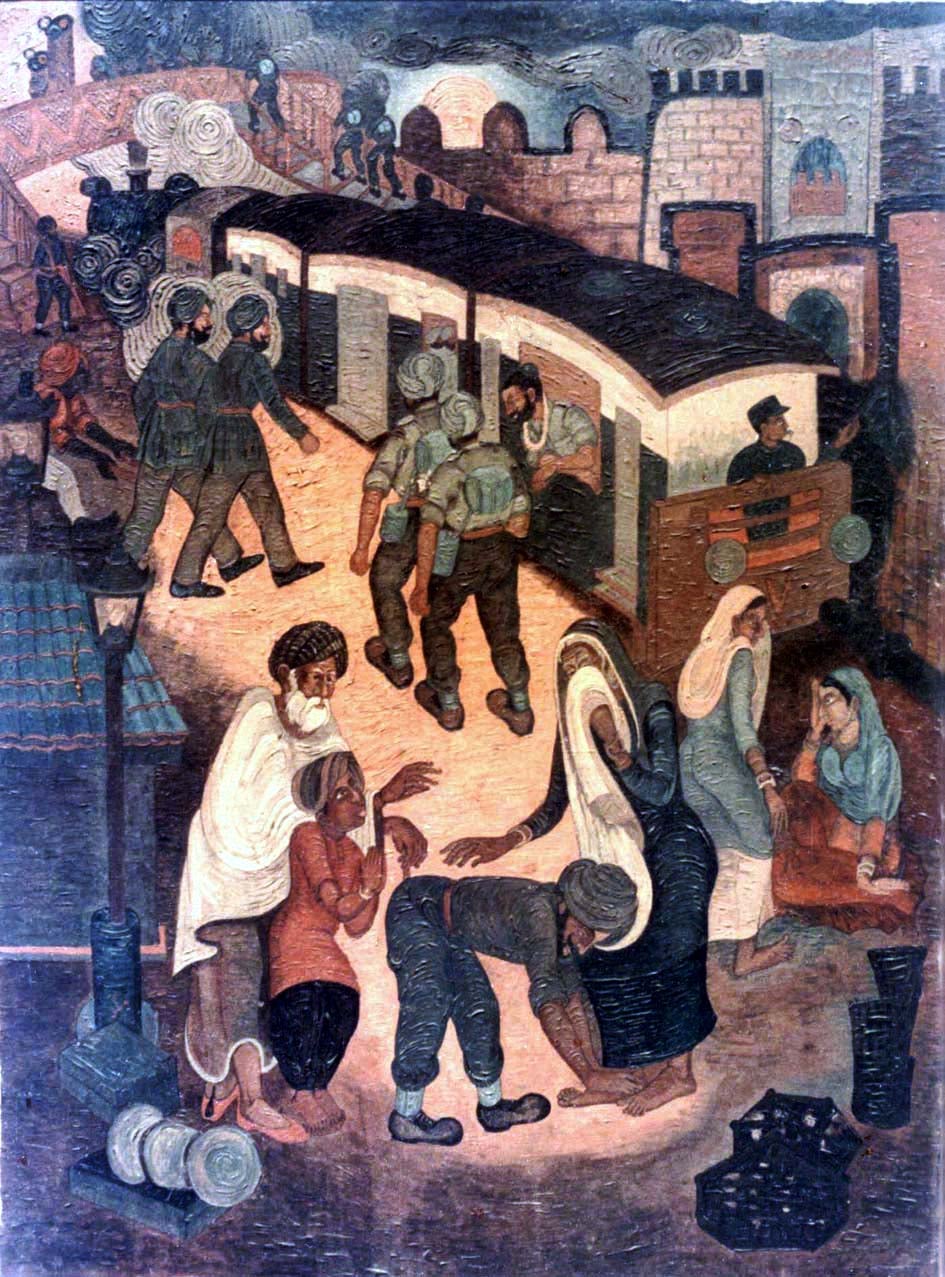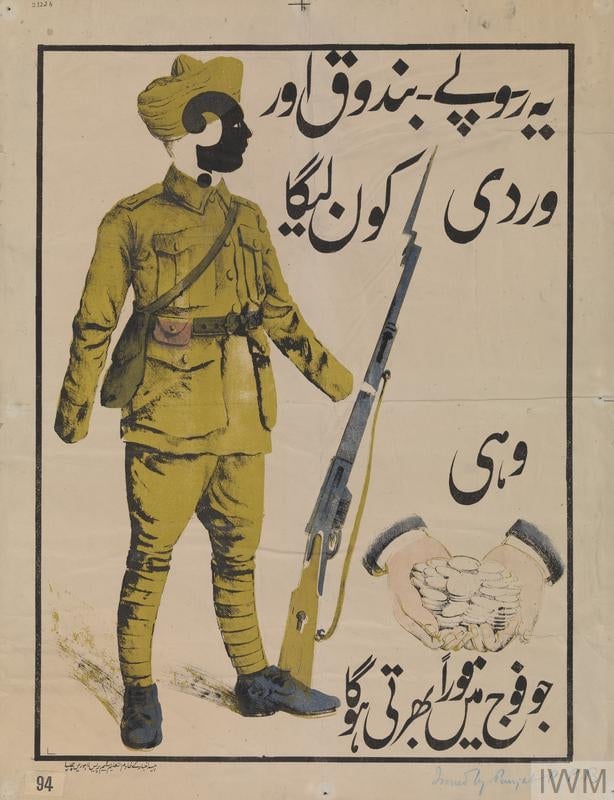Why half a million people from Punjab enlisted to fight for Britain in World War I
Let us start with a scene of farewell. A son touches the feet of his mother as we see soldiers embark on the train to the front. The elderly father looks on as the mother wipes away her tears with her chunni (scarf ). Emotion is suggested through gesture and colour rather than through the art of close-up. White, the colour of mourning, visually unites the grieving parents and spills over through the world of fabric to a similar scene on the right-hand corner with two distraught women, suggesting a wider female community of mourning, before the white is carried over to the waiting train—the cause of the sorrow, the harbinger of death.


Let us start with a scene of farewell. A son touches the feet of his mother as we see soldiers embark on the train to the front. The elderly father looks on as the mother wipes away her tears with her chunni (scarf ). Emotion is suggested through gesture and colour rather than through the art of close-up. White, the colour of mourning, visually unites the grieving parents and spills over through the world of fabric to a similar scene on the right-hand corner with two distraught women, suggesting a wider female community of mourning, before the white is carried over to the waiting train—the cause of the sorrow, the harbinger of death.
The painting, by the Punjabi artist Pran Nath Mago, is titled Farewell and was painted in 1945. The emollient contours and the flowing clothes of the civilian figures contrast with the Western military uniform and rigid gestures of the soldiers, while the three distant figures on a bridge amidst the billowing smoke of the train take the painting to a different place, different time—the world of no-return. The immediate trigger of the painting was the Second World War, but it was based on Mago’s childhood memories of soldiers taking leave at the Gujar Khan railway platform for the front during the 1914-1918 war. The painting fuses the two wars as both depleted Punjab of its young men.
The painting lifts the veil on what still remains one of the weakest links in First World War history: the colonial home front. Of the over one million Indians who served abroad, some 480,000 came from Punjab.
The massive recruitment figures from a single province were the fruition of a process that had begun in the nineteenth century—the “militarisation of Punjab” and the “Punjabisation of the Indian army.” Scholars have noted how Punjab’s frontier location with relation to Afghanistan and the display of Punjabi loyalty during the Sepoy Uprising of 1857 influenced the shift of the Indian army’s recruitment centre to this province. Political expediency was soon welded to Victorian racial ideology. As early as 1879, the Eden Commission Report noted that “the Punjab is the home of the most martial races of India and is the nursery of our best soldiers.”
Lord Frederick Roberts—the Commander-in-Chief in India from 1885 to 1893—was an enthusiastic proponent of the theory of the “martial races” and reshaped the class components of the Indian army, in particular replacing men from the “unmartial” south with the “martial” races of the north. The army was further reorganised by Lord Herbert Kitchener, who became the Commander-in-Chief in India in 1902.
The province soon evolved into the recruiting ground for soldiers and policemen for the empire. In August 1914, Punjab (including the British districts and princely states) had 100,000 men in its armies, including 87,000 combatants and 13,000 non-combatants; by the end of the war, Punjab had contributed one-third of all the Indian recruits and over 40% of the total number of Indian combatants mobilised. However, the conventional idea of Punjab as the “exceptional” colonial state—prosperous, loyal and unified—has increasingly come under pressure. As Mark Condos has recently argued, the “garrison state” was also the “insecurity state” par excellence, bristling with anxiety, almost bordering on panic, about its “warlike” inhabitants.
[…]
Mixed Motives: Livelihood, Tradition and Incentives
In 1914, India had one of the largest voluntary armies in the world. Of the 27,522 new recruits enlisted in India between August and Dec. 31, 1914, 13,400 were from Punjab alone. The total number of men to have served from Punjab, including the British districts and the Indian states, by the end of the war was 480,000, including 410,000 combatants and 70,000 non-combatants. Of the 282,170 combatants recruited from Punjab from 1915 until 1918, some 156,300 were Muslims, some 63,900 were Hindus, and 61,970 were Sikhs, though the last religious group—the Sikhs—comprised only 12% of the population.
These men were mostly “peasant-warriors” belonging to tribes designated as the “martial races” as mentioned in the introduction. Why did they enlist for a foreign war? The question has provoked much debate. The men, it was officially claimed, fought for their izzat; in his introduction to the letters of the Indian soldiers, David Omissi has observed that “Indian soldiers fought, above all, to gain or preserve izzat—their honour, standing, reputation or prestige,” a notion he goes on to develop in greater complexity elsewhere. On the other hand, Kaushik Roy, among others, has labelled them “quasi-mercenaries,” pointing to the dense network of “tangible goods and intangible incentives.” Part of the problem lies in the very definitions; can there be more of a common ground, particularly if we up-end the telescope and move from the colonial archives to popular culture?
At the outset, it must be admitted that even within Punjab it is not possible to impose a common motive for enlistment of the 480,000 men from this province, who ranged from members of the vast land-owning families of Western Punjab to the struggling peasant-proprietors of Gujrat, Rawalpindi, and Jhelum to the impoverished Dogras of Kangra. Motives varied widely, from military service being a source of livelihood to family tradition and rank within the army to how crops had done that season.
Enlistment was often intimately related to the history of a particular village, tribe, and caste. Moreover, men from families with several generations of soldiers would have had a different relationship to the army from that of the combatants from “non-martial” races recruited for the first time in 1917 when the recruiting base was substantially broadened. For each group, economic incentive was a central aspect, but one must take into account too nuances related to the more specific socio-cultural story of the region that intersected with issues such as family and community traditions, livelihood, faith, and masculinity, among other factors.

In the absence of testimonies, let us begin with what was promised on the recruitment posters. A common poster, depicting some scenes from the “early life of a recruit,” promises “Good Food, Good Pay, Good Treatment
One can read the Urdu poster along with a popular wartime recruitment song, which circulated both in Punjabi (Bharti ho ja ve) and in Haryanvi (Bharti ho lyo re):
Get enlisted, the recruits who stand out there,Here you get broken slippers, there you’ll get full boots, get enlisted,
Here you get torn rags, there you’ll get suits, get enlisted,
Here you get dry bread, there you’ll get biscuits, get enlisted,
Here you’ll have to struggle, there you’ll get salutes, get enlisted.
In the Haryanvi version in Jat Gazette, “suits,” “boots,” and “salutes” (mentioned in English) are contrasted with an alternative rhyme of “toote littar” (broken slippers), “phatt chitthde” (torn rags) and “sukhe tittar” (dry bread). Absent in both poster and song is any explicit appeal to imperial “loyalty.” In spite of the official rhetoric around “honour” or “izzat,” did the recruiting authorities know the hard truth, leading them to focus solely on incentives? The song tunnels deep into the history of military service in Punjab and translates economic logistics into the fabric of everyday life, felt on the skin and in the gut, and within the heart.
Military expenditure was the largest item in the colonial budget; 10% of the entire governmental budget went to Punjabi soldiers in 1912-1913. Once in the army, young recruits, used to rough village khaddar , would wear uniforms of machine-made finer cotton and enjoy a better diet, including a wider selection of vegetables. The key word, however, is “salute,” indicating how such service was perceived in the community.
If the idea of an organic izzat-fuelled sepoy is now being increasingly dismissed as the product of colonial myth-making, the idea of the sepoy as a hardened mercenary, on the other hand, speaks to a post-nationalist moment rather than to the complex psychosocial world of the sepoy in 1914. The craved-for “salute,” while intimately related to, and dependent on, land and money, could not wholly be reduced to them; a Victoria or Military Cross, or even a far lesser medal, had a certain aura and prestige in the community that went beyond the colour of money.
While military historians have increasingly noted the role of “society and politics” in shaping the army, such observations also need to be nuanced to a more intimate history of feelings. The colonial patronage, high visibility, and consequent prestige accorded to the Punjabi soldier from 1880 to 1920 created their own particular affective structures. Two issues, in particular, should be noted. First, in 1914—when Indian nationalism had not fully defined itself and the prestige of the empire was unmatched—employment in the British Indian army was a source of considerable pride and prestige; at the same time, there was ambivalence too, conscious or unconscious (as both Anand and Ghosh point out) about serving in the colonial army, but held in check by a range of factors, tangible and intangible. Second, as the economic historian Imran Ali has observed, military service was much more than just a “career”: “such ‘professionalism’ had not clarified itself in the consciousness of the Punjabis. Instead, military service was regarded as a vehicle for establishing one’s status, as an individual but more importantly as part of a social group.”
[…]
Economic incentive was central, but it needs to be considered in conjunction with a variety of factors. Military service in Punjab was indissolubly associated with its agricultural economy. For many in the arid tracts of Shahpur, Jhelum, and Attock, the army was the main source of livelihood; for small-scale peasant proprietors, it supplemented agricultural income. In The Punjab Peasant in Prosperity and Debt (1925), Malcolm Darling noted that “the bulk of cultivators of the Punjab are born in debt, live in debt and die in debt.” A survey done at the time revealed that 83% of the land-proprietors were in debt. A land survey done in 1926 showed that 23% of the cultivators had one acre or less, 33% had one to five acres, 20% had five to 10 acres and 24% had over 10 acres. It is revealing that the most heavily recruited part of India was Rawalpindi, where the average landholding was less than five acres, while some of the most “disappointing” rates of recruitment happened in the more prosperous canal colonies.
On the other hand, in the arid tracts of northern Gurdaspur and the Kangra districts where numerous recruits for the Dogra companies were raised, enormous amounts of cash flowed in during the war years, providing a lifeline to the entire tribe; in Gurgaon, between 1915 and 1917, remittances and pensions for military service exceeded the land revenue by Rs75,000. The army, for Darling, “has not only saved these people from penury but has even made them prosperous.”
Excerpted with the permission of Cambridge University Press from India, Empire and First World War Culture by Santanu Das. We welcome your comments at [email protected].